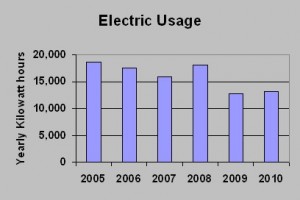House: Built in 1950’s, remodeled multiple times most recent addition 2008. 2800 square feet

System Description: The co-generation system produces electricity and heat at the same time. When the heat is turned on, a small generator (MCHP — micro combined heat and power unit), which is run by propane, produces electricity used for the house. Any extra electricity is fed into the grid, making the meter run backwards. The waste heat produced by generating electricity goes through a tube to the furnace and is distributed through the house. The furnace can also run on its own if more heat is needed on very cold days. The system produces forced hot air heating but also would work with water-based heating. It is a prototype system, the first one in the country to test a system fueled by propone gas rather than natural gas.
The system is not turned on during the summer, since there is nowhere for the heat to go.
Components: a 95% efficient propane furnace (runs with or without the mCHP), an MCHP (micro combined heat and power unit). Wall-mounted control system with visability via .IP interface
System provides: Approximately 1/3 of annual electricity and ½ of the of electricity during the winter months,
Back-up heating and hot water system: Oil-fired furnace and electric hot water tank
Town permits involved: Yes
Advantages: The core advantage of having the mCHP is that the home burns 1 source of fuel and gets both electricity and heat. They home would burn the propane for heat regardless, and now we cut a minimal of $600-$900 off our electric bill per year.
Disadvantages: The price of propane is tied to the cost of crude oil, which is volatile. The price of electricity in N.E. is tied to the natural gas prices. Thus running the unit can be more expensive than the real price of electricity.

